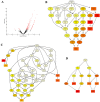Transcriptome sequencing of neurologic diseases associated genes in HHV-6A infected human astrocyte
- PMID: 27344170
- PMCID: PMC5217001
- DOI: 10.18632/oncotarget.10127
Transcriptome sequencing of neurologic diseases associated genes in HHV-6A infected human astrocyte
Abstract
Human Herpesvirus 6 (HHV-6) has been involved in the development of several central nervous system (CNS) diseases, such as Alzheimer's disease, multiple sclerosis and glioma. In order to identify the pathogenic mechanism of HHV-6A infection, we carried out mRNA-seq study of human astrocyte HA1800 cell with HHV-6A GS infection. Using mRNA-seq analysis of HA1800-control cells with HA1800-HHV-6A GS cells, we identified 249 differentially expressed genes. After investigating these candidate genes, we found seven genes associated with two or more CNS diseases: CTSS, PTX3, CHI3L1, Mx1, CXCL16, BIRC3, and BST2. This is the first transcriptome sequencing study which showed the significant association of these genes between HHV-6A infection and neurologic diseases. We believe that our findings can provide a new perspective to understand the pathogenic mechanism of HHV-6A infection and neurologic diseases.
Keywords: HHV-6; astrocyte; neurologic diseases; transcriptome sequencing study.
Conflict of interest statement
None of the authors have any conflict of interest.
Figures




Similar articles
-
Hypothesis: Is there a link between the immune response to Human Herpes Virus type 6Α (HHV-6Α) infection and the interaction network (interactome) of the genes encoding the CTSS, PTX3, CHI3L1, Mx1, CXCL16, BIRC3 and BST2 proteins?Med Hypotheses. 2018 Mar;112:47-50. doi: 10.1016/j.mehy.2018.01.011. Epub 2018 Jan 31. Med Hypotheses. 2018. PMID: 29447938
-
Variant-specific tropism of human herpesvirus 6 in human astrocytes.J Virol. 2005 Aug;79(15):9439-48. doi: 10.1128/JVI.79.15.9439-9448.2005. J Virol. 2005. PMID: 16014907 Free PMC article.
-
Differential HHV-6A gene expression in T cells and primary human astrocytes based on multi-virus array analysis.Glia. 2006 Jun;53(8):789-98. doi: 10.1002/glia.20333. Glia. 2006. PMID: 16541415
-
Clinical impact of primary infection with roseoloviruses.Curr Opin Virol. 2014 Dec;9:91-6. doi: 10.1016/j.coviro.2014.09.013. Epub 2014 Oct 14. Curr Opin Virol. 2014. PMID: 25462439 Free PMC article. Review.
-
Clinical and laboratory features of human herpesvirus 6 chromosomal integration.Clin Microbiol Infect. 2016 Apr;22(4):333-339. doi: 10.1016/j.cmi.2015.12.022. Epub 2016 Jan 21. Clin Microbiol Infect. 2016. PMID: 26802216 Review.
Cited by
-
The Role of Human Herpesvirus 6 Infection in Alzheimer's Disease Pathogenicity-A Theoretical Mosaic.J Clin Med. 2022 May 29;11(11):3061. doi: 10.3390/jcm11113061. J Clin Med. 2022. PMID: 35683449 Free PMC article. Review.
-
DR7 encoded by human herpesvirus 6 promotes glioma development and progression.Cancer Manag Res. 2019 Mar 12;11:2109-2118. doi: 10.2147/CMAR.S179762. eCollection 2019. Cancer Manag Res. 2019. PMID: 30881135 Free PMC article.
-
Viruses and endogenous retroviruses in multiple sclerosis: From correlation to causation.Acta Neurol Scand. 2017 Dec;136(6):606-616. doi: 10.1111/ane.12775. Epub 2017 May 23. Acta Neurol Scand. 2017. PMID: 28542724 Free PMC article. Review.
-
Exploring New Mechanism of Depression from the Effects of Virus on Nerve Cells.Cells. 2023 Jul 3;12(13):1767. doi: 10.3390/cells12131767. Cells. 2023. PMID: 37443801 Free PMC article. Review.
References
-
- Zerr DM, Meier AS, Selke SS, Frenkel LM, Huang M-L, Wald A, Rhoads MP, Nguy L, Bornemann R, Morrow RA. A population-based study of primary human herpesvirus 6 infection. New Engl J Med. 2005;8:768–776. - PubMed
-
- Dockrell DH. Human herpesvirus 6: molecular biology and clinical features. J Med Microbiol. 2003;(Pt1):5–18. - PubMed
-
- Boehmer P, Nimonkar A. Herpes virus replication. IUBMB life. 2003;1:13–22. - PubMed
-
- Flamand L, Komaroff AL, Arbuckle JH, Medveczky PG, Ablashi DV. Review, part 1: Human herpesvirus-6-basic biology, diagnostic testing, and antiviral efficacy. J Med Virol. 2010;9:1560–1568. - PubMed
-
- Chen T, Hudnall SD. Anatomical mapping of human herpesvirus reservoirs of infection. Modern pathol. 2006;5:726–737. - PubMed
MeSH terms
LinkOut - more resources
Full Text Sources
Other Literature Sources
Medical
Miscellaneous

